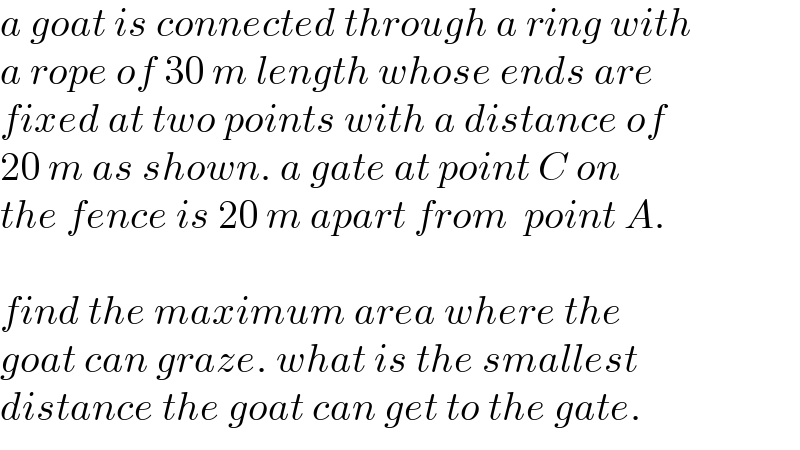
Question and Answers Forum
Question Number 181619 by mr W last updated on 27/Nov/22

Commented by mr W last updated on 27/Nov/22

Answered by Acem last updated on 27/Nov/22

Commented by Acem last updated on 27/Nov/22

Commented by Acem last updated on 27/Nov/22

Commented by mr W last updated on 27/Nov/22

Commented by Acem last updated on 28/Nov/22

Answered by mr W last updated on 27/Nov/22

Commented by mr W last updated on 27/Nov/22
![the maximum area the goat can reach is an ellipse with semi axes: a=15 b=(√(15^2 −10^2 ))=5(√5) ((x/(15)))^2 +((y/(5(√5))))^2 =1 ⇒y=5(√5)(√(1−((x/(15)))^2 )) A=2×5(√5)∫_(−10) ^(15) (√(1−((x/(15)))^2 ))dx =75(√5)[sin^(−1) (x/(15))+(x/(15))(√(1−((x/(15)))^2 ))]_(−10) ^(15) =75(√5)((π/2)+sin^(−1) (2/3)+((2(√5))/9))≈469.14 m^2 say P(−a cos θ, b sin θ) ((10−15 cos θ)/(20−5(√5) sin θ))=((5(√5) cos θ)/(15 sin θ)) ⇒(3/(cos θ))−((2(√5))/(sin θ))=2 ⇒θ≈1.1249 d_(min) =(√((10−15 cos θ)^2 +(20−5(√5) sin θ)^2 )) ≈10.29 m](Q181635.png)
Commented by mr W last updated on 27/Nov/22

